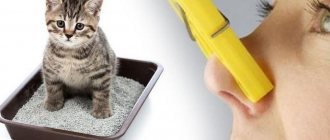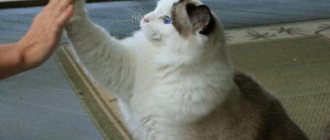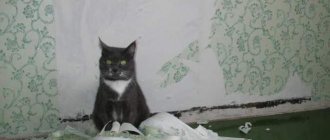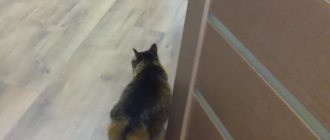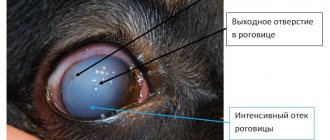Changes in composition, place of residence, even fresh renovations can make the owners want to move the cat litter box to a place that is more convenient, from their point of view. It’s just not a fact that the pet will approve of such changes. A one-time “embarrassment” can develop into a persistent bad habit. Do you want to know how to train an adult cat to use a litter box in a new place without any problems?
The desire to change the location of the cat litter box is also relevant at the beginning of the training process, if the tray had to be temporarily placed in the place chosen by the pet. And also, if you move, go on a trip with your pet, go to visit and take a “travel tray” with you.
Preparation
The appearance of a kitten in the house - such a decision should be made at a family council, since its presence should evoke positive emotions. If you are bothered by the noise caused by the kitten’s playfulness, its nightly “vigils,” and its fur constantly flying in the air, then you should wait to purchase a kitty.
Before the baby arrives in the house, it is necessary to make some preparations. First of all, this concerns the choice of tray. The store sells trays with different side heights. If you have already decided on the breed, you can guess the future parameters of your pet. The tray should be designed for an adult cat, since it is quite possible for a small kitten to overcome a side that is twelve centimeters high, but a grown cat will feel uncomfortable in a ditch that is not the right size.
The next step is where the tray will stand. The corner should be secluded, as the kitten does not like to show off its affairs. A toilet or bathroom is good for these purposes, provided there is enough space. The main thing is that the pipes do not rattle and the water does not make loud noise, which can scare away the baby.
It is important to find out from breeders or previous owners how their kitten went to the toilet. If you used a certain brand of filler, then purchase exactly that one for the first time, and then gradually replace it with the one you prefer. If the kitten went to the newspaper, then you will have to use this option, and then switch to a more convenient one.
And remember, the litter box should appear in the house with the kitten, and no inheritance from previous furry residents or neighbors. Cats have an excellent sense of smell, and no matter how hard you try to wash the used tray for the new owner, everything will be to no avail.
Special pads for training a cat to use the toilet
Often difficulties arise at the final stage of training, when the tray needs to be installed on top. The box may not be the right size, making it difficult to jump into. It is more rational to use special attachments sold in pet stores.
On a note! Stores sell special liquids containing certain enzymes for toilet training cats. In this system, they can be used instead of litter or in addition to litter if the animal does not go right away.
Toilet training system for cats.
Training a kitten to use the toilet.
The principle of operation of the system is to sequentially expand the hole in the middle until a regular lining is obtained. They come in 2 types:
- plastic container fixed to the toilet. It already contains markings for cutting out circles of different diameters. Start with the smallest one and increase it by one contour every 5 days. When the cat confidently begins to stay on the rim and recovers, the nozzle is removed;
- a system that includes several rings of different diameters, inserted into each other according to the pyramid principle. It is enough to periodically remove one ring at a time to expand the hole in the center.
More advanced designs are also sold, equipped with folding legs (for gradual lifting) and retractable curtains. With their help, the process of training a pet will become as simple and convenient as possible.
On a note! When choosing a system, be sure to take into account the weight of the animal. Large representatives require durable plastic to withstand heavy loads.
A plastic toilet seat cover for cat training makes this process easier.
You can make your own plastic mesh cover from a cat potty.
There are reusable systems, they are designed a little differently. They include a set of plastic pads with holes of different sizes, which are changed as the animal gets used to it.
On a note! The most popular cat training devices among buyers are: Domakot, Unikot, Vaka, Litter Kwitter, CitiKitty Cat Toilet Training Kit.
Reusable plastic pads are replaced as the cat gets used to the new conditions for relieving itself.
When purchasing pads, you must take into account the weight of your pet and the thickness of the plastic of the product. The heavier the cat, the more massive and thicker such a device should be.
How to accustom a kitten to a litter tray
Here are some recommendations that you can follow to quickly train your kitten to use the litter box.
- The first thing to do is to limit the space in which your new family member eats, sleeps, and frolics. This measure is necessary to ensure that the kitten is always visible for the first few days. Try to locate this area closer to the room where you spend most of the time. In this case, it will be possible to constantly keep the kitten in sight and quickly take action if he does not want to use the litter box.
- It is necessary immediately, as soon as the kitten gets into the new room, to show him the tray and the place where he stands. From time to time, place your furry family member in a litter tray so that he can remember the smell.
- Strictly control food intake and sleep time so that you can immediately take him to the potty.
- When placing the kitten in the tray, see if it drips clay or sawdust. If not, then grab him by the paws and make raking movements with them. Such attempts must be repeated several times.
- The kitten must be supervised at all times. If you notice that he sits down past the tray, carefully without sudden movements or haste, move the baby into the tray. He will have no choice but to use your service. When finished, be sure to pet him and praise him.
- If an “accident” does occur, blot the puddle with an odorless napkin and place it in the filler. The smell of urine in cats is very persistent and will attract his attention next time.
- For exemplary behavior, be sure to praise the kitten by talking affectionately to it. And if the kitten avoids the litter box over and over again, be patient, don’t even think about yelling at him, much less hitting him hard, and be persistent in the process of training the kitten to use the litter box.
Rules for toilet training your pet
Usually, kittens are taught the rules of personal hygiene and toilet use by their mother in the first months of life. Accordingly, if the cat herself regularly goes to the tray, then by her example she will demonstrate to the cubs how to use this accessory. But even if a kitten has already been trained by a cat, when it gets into a new home, it takes time for it to get used to the new environment and the toilet. As a rule, in this case the training process takes a minimum of time and can even be limited to 1 day. If the kitten is separated from its mother too early, the learning process falls entirely on the owner’s shoulders.
To successfully train a kitten to use the litter box, follow these rules:
- When picking up a kitten from its previous owner, ask him for a handful of litter from the tray. The cub will quickly understand what's what when he catches a familiar smell in the new home, and uses the tray for its intended purpose.
- Introduce your pet to the litter box. Place the kitten there and give it the opportunity to look around and sniff. Let it sit or lie there, it is not necessary to immediately use it for its intended purpose.
- Demonstrate how to rake out litter.
- Place in the tray immediately after eating or sleeping. As a rule, kittens defecate almost immediately after eating or waking up. Gently hold your pet under the tummy and place it in the tray. Stay nearby, talking affectionately to the animal.
- Praise for success. When your baby uses the toilet as intended, pet him and praise him. Don’t rush to clean the tray right away, let an olfactory connection with this place be established.
- Be patient. The length of toilet training depends on the character of the animal itself and your consistency. Some people manage to train an animal in 1 day, while others need several weeks. In any case, you should not scold the baby or poke his face into the puddle - this will cause distrust and fear of the owner, but will not help speed up the process.
- Work on your mistakes. If the kitten went to the toilet in the wrong place, transfer the pile to the tray using a scoop, and thoroughly wash the scene of the “crime” with water and vinegar to discourage the desire to repeat the experiment.
- Move the tray as necessary. If the pet does not want to run to the toilet to relieve itself, but relieves itself in another room, temporarily place the tray in this room. When the kitten gets used to this location, gradually move the tray to the permanent toilet.
Video: how to train a kitten to use a litter tray
Features of training an adult cat
If an adult cat has appeared in your home and is not toilet trained, the procedure is approximately the same as with a kitten. However, the training period may extend over a longer period. An adult animal has established habits; it is more difficult to retrain it than a kitten. Of particular importance is the type of filler and tray model. If possible, take the container from the previous owner or at least find out what kind of filler the pet prefers. Cats from the street or from a shelter are usually loyal to wood and mineral fillers.
If a cat that has been living in the house for a long time suddenly stops going to the toilet in the designated place, it is important to understand the reason for this behavior. Your pet may be experiencing health problems. Thus, due to diseases of the genitourinary system, the animal ceases to control the process of urination. After completing the course of treatment, the cat will again become disciplined in toilet matters. During periods of heat or mating season, the animal can mark its territory by spreading its pheromones to attract a sexual partner. In this case, taking sedatives or drastic measures - sterilization or castration - will help.
A cat may relieve itself in unspecified places for psychological reasons. For example, due to a conflict with the owner, stress, or the appearance of another pet in the house. This usually manifests itself as “peeing” in corners, near doors and windows. This is how the animal tries to assert itself, indicating that it belongs to the territory. The problem can be solved with the help of sedatives, but sometimes only castration helps.
Consider the following tips to help toilet train an adult cat:
- At first, limit your area of stay. In one room, place bowls with water and food, a tray, toys, and a scratching post. Let the animal master this room and get used to the tray. When this happens, expand the area, gradually moving the tray to the desired location.
- Use the associative method. Transfer feces left in an unexpected place to the tray, wipe up puddles with a paper towel and also place them in the tray. Chemical toilet training products may also help. For example, the attractive drug Himola is intended to develop the habit of relieving oneself in a certain place. It has a smell similar to natural and is available in the form of a spray. Spray a piece of paper with it and place it in the tray. Having smelled the aroma, the cat will rush to do its business in the tray.
- Repel unpleasant odors. If your cat gets into the habit of going to the toilet in the same unwanted place, spray it with repellent sprays. They are sold in pet stores and have an extremely unpleasant odor for cats. As an alternative, folk remedies are also suitable - vinegar, vodka, citrus peels, rosemary and others.
- Place food in the wrong place. Cats are naturally squeamish and will not shit where bowls of food and drink are. The pet will be forced to give up the idea of going to the toilet near food and water.
- Give the right to choose. Wayward cats may refuse to go into the litter box if they don't like the litter or the container itself. Buy different types of soil and trays, use different combinations to please the stubborn one and find a compromise.
- Change the filler in a timely manner. Cats hate having things stick to their paws or having to step on wet surfaces. Dirty litter can cause an animal to refuse to go to the toilet. Try to keep the inside of the tray clean every day and change the filler completely when it gets dirty.
Reviews from breeders about toilet training cats
I had 3 cats, all of them were trained the same way. The Peeves followed on his heels for three days and, as soon as the kitten began to settle in (sniff and twirl), they put him in a pot. That was enough. But no one went to the grid, it’s not convenient for the animal. Better filler.
Alyona
https://www.woman.ru/home/animal/thread/3971506/
I taught him this way - when he eats, I immediately put him on the potty - I’ll sit next to him, poke his butt)). I also sprayed “Antigadin” 9, sold in any pet store, kills the smell of their urine), and also laid foil on the place where he tried to pee all the time (the kitten cannot sit on the foil and therefore does not go to this place anymore). And the best thing that helped me was regular sand, the kitten liked to rummage there so much!!!
Cancel OK
https://www.woman.ru/home/animal/thread/3971506/
Soak the piece of paper in urine and place it in the tray with the filler. As soon as you see him stomping around (looking for a place), grab him and put him in the tray. My stray cat figured it out instantly and never missed a beat.
IrenAr
https://deti.mail.ru/forum/dosug/bratja_nashi_menshie/kak_priuchit_kotenka_k_lotku_1500992536/
My wife first brought a cat from the street (kitten). On the second day she (the cat Sophie) began to go to her toilet. But with the advent of the puppy, they began to go to the balcony together. Unfortunately, I had to part with the puppy (he began to grow by leaps and bounds). And the cat began to go to his toilet again. True, out of revenge, she once walked into my sneakers. And as for training: he poked his muzzle into her “business” a couple of times, then into the tray. Understood. It still depends on the toilet filler. There are also those that immediately smell like cat litter. And the cat's instinct kicks in.
riens
https://blogotshelnika.ru/forum/topic423.html
Ideally, lock him in the toilet and sit next to him. As soon as you start looking for a place to take a shit, immediately take him to the potty. Lock it up and don't let it out until it goes away. Physiology will not allow him to endure for long. Just sit next to him and sit him down, you need to teach him
Kitty
https://blogotshelnika.ru/forum/topic423.html
When I took my street one, I consulted: I needed a large tray with sides and fine mineral filler. The kitten is an outdoor kitten, accustomed to digging in the ground. I immediately went to rummage through this tray. Moreover, first you need to place the tray not far from the bowl - with kittens everything is quick - they eat, go to the toilet. Then you will gradually move the tray to the desired location. I later changed the filler from mineral to wood - the smell holds better and doesn’t make as much noise when they look for oil in it)) but that’s for later. First mineral - it looks more like earth
JGh*Darling
https://www.u-mama.ru/forum/family/pets/400151/index.html
Video: how to stop a cat from shitting anywhere - instructions for use
How to accustom a kitten to a litter box without litter
The purchase of filler entails significant expenses for the family budget. If you can't afford it, you can train your kitten to use a litter box without litter. Show the tray to your baby and rummage along the bottom with your paws. If, however, a puddle appears in the wrong place, blot it with a clean, odorless napkin and place it in a tray to transfer the kitten’s amber into it.
After some attempts, the kitten will learn to go to an empty tray. But it is important that after each use of the toilet, be sure to wash the cuvette with clean water, without bleach or any detergents. Otherwise, a urinary stone will quickly form at the bottom.
Often cat owners use torn newspaper as litter for the tray. Kittens like this method. But again, this “filler” must be removed after each trip to the toilet. Otherwise, the pet will ignore the wet tray and do its business elsewhere.
The version of the tray without filler is suitable only for owners who are constantly at home and can clean up after the kitten in a timely manner. If the kitten is alone at home all day or most of the day, then the option of loose litter for the tray will be the only acceptable one. If filled with enough filler, your pet can go several times without any problems. Just when you come home from work, do something nice for him - put the tray in order.
How to choose a tray?
Did you know that cat litter boxes can also be closed? These look like houses, cat carriers, and even bedside tables. Closed trays are good if the cat likes to sit on the edge of the toilet and scatters the litter
or, like my Judy, she splashes squirts. And even with this look: “fi-fi-fi, what did I get dirty in!” For shy cats (there are some), a closed tray is also just right. It has less odor, but it is more difficult to clean such a toilet. If you hesitate with cleaning, the cat will find a cleaner place.
At first, it is better to choose an open tray
.
It comes with a lattice (they do not add filler to these) and without, with high sides. The tray with the mesh must be washed after each “visit” of the cat. This is troublesome for lazy owners. But the cat has the last word: the main thing is that the tray fits him .
The toilet should be spacious and suitable for the pet’s height. Therefore, for kittens, choose trays with not too high sides. And one more thing: if there are two “mustachioed” people in the house, each should have its own toilet.
If the cat shits everywhere
But sometimes it happens, no matter how much effort you make to accustom your cat to the litter box, from time to time she craps wherever she pleases. It often seems that the cat does this because of its grievances. But this is not true. In fact, this “disgrace” may have several reasons.
In this state of affairs, experts advise doing a full examination of the cat’s body. After all, persistently ignoring the filler can signal the initial stage of serious diseases. These could be kidney or bladder problems, constipation, or inflammation of the thyroid gland. If the doctor did not reveal any pathology, then the cause of hooliganism lies only in your uncleanliness. To make a cat feel comfortable, a minimum of effort is required, namely:
- Throw away a lump of wet litter every day;
- Renew it in small doses;
- Once a week, be sure to remove all the litter and then thoroughly wash the tray using urinary stone removers and disinfectants. Wipe the tray dry.
If the activities described above are carried out by you with enviable regularity, you need to look for another reason for refusing the tray. This may be the quality of the filler itself. It is good to use the filler that was used by the breeder. It is possible to use the same absorbent composition. The cat, out of established habit, will definitely sit on such soil.
When changing the filler, this must be done with caution. First add it a little at a time so that the cat can get used to it, and then after a while replace it completely.
It is necessary to talk separately about the filler. It comes in various qualities, sizes and purposes. Fillers are divided into:
- Moisture-absorbing;
- Clumping;
- Selicohelium.
The first and second are made from a certain clay or wood shavings, pressed into certain granules. The latter are made from specially processed polysilicon clay. But due to the complex form of manufacture, this filler is much more expensive than others. Its high cost is compensated by its high efficiency, so one serving can be used for up to four weeks.
If the cat does not go to the litter box, but poops anywhere, then the litter is not suitable for her. And you will have to start selecting it.
Let's organize a cat litter box
You should take care of arranging a place for your pet’s toilet even before the animal first crosses the threshold of your home. On the very first day the kitten is born, it is necessary to let him know where not only the bowls of water and food are located, but also the tray for relieving his natural needs. To prevent the animal from getting lost in a new and huge room, limit the area where it stays to 1-2 rooms, and cover the rest with a door - the kitten will be able to visit them when it gets used to it. If other pets already live in the house, move them away from each other for a while to avoid conflicts and increased stress for the “newbie” who has just changed his place of residence. It is important to provide a sufficient number of trays for all animals. Veterinarians advise installing 1 more trays than pets. Each pet will have its own litter box and 1 spare litter box, in case the permanent litter box becomes dirty and does not attract its owner.
Secluded areas of the room, hidden from prying eyes and protected from drafts, are optimal for the location of the toilet. Cats like to be alone when they relieve themselves. Most often, breeders place a tray in the bathroom. It is important that the pet always has access to this room. Once he stumbles upon a closed door, he will be forced to choose another place to relieve himself, and go there in the future, even if access to the toilet is unlimited. Consider placing the tray in the hallway - then the problem of a closed door will disappear, and access to the toilet will always be free. If you don't want your cat's litter box to be visible to everyone, choose an enclosed, tall container or litter box.
Cats love to feel confident in everything, including that the litter box is comfortable and not dangerous. If the container slides on the tiles in the bathroom or one day toilet paper falls on your pet, this may be a reason to refuse to visit this place. If necessary, place a rubber mat under the tray - it will help prevent slipping, and make sure that nothing disturbs your pet while he is in the toilet.
Types of trays and features of choice
Before you buy a tray, decide on your preferences or evaluate the characteristics of your pet if it has been living in the house for a long time. Think about what size the litter box should be so that the cat can turn around comfortably in it, and the loin part does not hang outside the tray at the most crucial moment. Don't be afraid to buy a container that's too big—the larger the surface area, the better, and kittens grow quickly. If you have an adult cat and she has a wayward character, you should offer her several models so that she can choose the appropriate option. It is important to pay attention to the practicality of the tray - is it convenient to disassemble and wash? If you plan to use litter, you should give preference to trays with high sides so that the granules do not crumble when the cat digs up the soil. When planning to do without filler, choose a container with a mesh - then the liquid will drain into the tray, and your pet’s paws will remain dry. Trays are sold in pet stores, and the most practical material is plastic - it does not absorb odors and is easy to clean. In addition, the wide range of colors of the products allows you to choose a container to match the color of the interior of the room. Immediately purchase a special scoop to make cleaning the toilet easier.
Open tray without mesh
The simplest option is a one-piece container into which filler is poured. Slightly more advanced models have removable sides that prevent filler from falling outside the tray. The shape of the product is most often rectangular, but there are also triangular trays that are convenient to place in the corner of the room.
Advantages:
- it’s convenient for the cat to climb in,
- low price,
- compactness,
- easy cleaning.
Flaws:
- filler must be used
- if there are no sides, the cat throws the filler onto the floor,
- Doesn't hold odor.
Open tray with mesh
It differs from the previous model by the presence of an insertable plastic mesh. This allows you to do without filler, because the cat's feces flow into the lower part of the container, and the animal's paws remain clean. During cleaning, the mesh is removed, the contents of the tray are thrown away, and the parts are washed.
Advantages:
- no need to use filler,
- The cat's paws are clean and do not stain the floor,
- low price.
Flaws:
- does not retain odor
- must be washed after each visit by the cat,
- The pet may not like it due to the lack of material for digging.
Tray house
Being in a tray with a roof and walls, like in a house, the cat feels protected. This model hides the contents of the container from strangers and looks aesthetically pleasing. Advanced models can even be equipped with filters to trap unpleasant odors. The house can be with or without a door, have steps or a direct entrance. Cleaning, as a rule, does not cause difficulties, but requires disassembling and assembling the structure and periodically changing filters, if any.
Advantages:
- retains odor
- the filler does not scatter on the floor,
- large selection of modifications,
- original design.
Flaws:
- high price,
- large dimensions,
- The cat may not like it as a toilet, but can be used as a house.
Self-cleaning tray
The brainchild of modern progress is an automatic tray that can independently clean the litter from feces and lumps of urine. Using a special mechanism, the contents are sifted, and solid waste is moved into a compartment with a garbage bag. The owner can only remove the filled bag and throw it in the trash, and install a new bag in the compartment. The most advanced models are fully automated, connect to the toilet and flush waste into the sewer after the cat has visited it, clearing it of litter, if any. In this case, nothing threatens the cat - using sensors, the device detects the presence of the animal in the tray and turns on only after it leaves the toilet.
Advantages:
- no unpleasant odors,
- the ability to do without filler,
- keeping the tray clean,
- self cleaning.
Flaws:
- high price,
- the likelihood of the cat being scared.
Photo gallery: models of trays for cats
You can hide the tray from prying eyes in furniture and interior items
Tray with mesh can be used without filler
If it is more convenient for your cat to jump into the litter box from above rather than from the side, you should purchase a closed litter box with a door on the roof.
The automated tray is connected to the sewer; a person is only required to periodically add fresh filler
High sides and a nozzle on top will prevent filler from getting onto the floor
The cheapest option is a plastic container without any attachments, usually gets the approval of cats
To clean the tray, it must be removed from the general structure
Using the sifter grid, it is easy to remove contaminated filler
You can make a closed toilet from a box by cutting a hole for the animal to enter
Corner tray - a compact and simple model for placement in the corner of the room
Types of tray fillers
The success and speed of accustoming a cat to the tray largely depends on the correct choice of litter. The practical purpose of the filler is to absorb moisture and unpleasant odors. The filler is changed as it gets dirty; the frequency of cleaning depends on the characteristics of the substrate itself. For a cat, this is an analogue of natural soil, which she digs up before going to the toilet, and then buries excrement with satisfaction. The litter can also be replaced by “improvised” materials - torn newspaper or sand from the playground, however, these materials do not retain the odor and require cleaning as soon as the animal visits the toilet.
Pet stores offer a wide range of fillers made from different materials, differing in cost, appearance, degree of moisture absorption and other indicators. In this case, the final word remains with the cat - a wayward animal may prefer exactly the filler that it likes for deeply subjective reasons. Some cats can do without litter at all if they have been taught this since childhood, and the design of the tray allows them to keep their paws clean. Most felines, however, prefer a litter box, and the process of digging and burying soil is akin to a ritual for them. If your cat is unpretentious and takes well to any type of litter, choose a product that meets your requirements in terms of price, practicality, and ease of use. If necessary, you can combine different types. For example, put wood filler on the bottom to ensure maximum absorption, and mineral filler on top, which can prevent the spread of unpleasant odors.
Wood filler
The most accessible and inexpensive type. It is sawdust compressed in the form of granules. The sizes of granules can vary significantly - small grains are suitable for kittens, and larger grains are suitable for older cats. Wood material absorbs moisture well, partially suppresses odor, and does not cause allergies in animals and people. When urine gets on sawdust, it swells, the granules crumble, can stick to the cat's paws and spread throughout the apartment. However, you can solve the problem by placing a mat under the tray, the area of which exceeds the size of the container. Then the sawdust will remain on the mat when the pet walks on it, leaving the toilet. The cost of wood filler is low - from 50 rubles. per package.
Clumping filler
One of the most popular and sought after types. The material used is bentonite clay. The main advantage of such soil is its ability to form lumps when wet, which can be easily removed with a spatula. In this case, the dry part of the filler remains in the tray; there is no need to completely change the contents. The only significant disadvantage is that if the tray is not cleaned sufficiently or on time, the filler gets wet and dirty - the animal can leave lime marks on the floor. Also, clumping litter does not retain odors and can be dangerous for kittens who try to taste it. The cost of packaging starts from 100 rubles.
Zeolite filler
The material used is the natural mineral zeolite, which has excellent absorbent properties. It retains odors and moisture well, distributing it evenly throughout all granules. The cat's paws remain clean. If you pour the zeolite filler into the tray in a thick layer (about 5 cm), then completely changing the contents just once a week, periodically emptying it of feces.
Grain and cellulose fillers
Made from waste from the paper or grain industry. In the first case, waste paper is used, in the second - bran, corn cobs, and soybeans. Despite their low cost, these types of filler moderately inhibit odors, absorb moisture well and are considered economical. The main disadvantage is the lightness of the granules, which is why the filler is carried on the pet’s paws throughout the house. The cost of packing the filler is about 80 rubles.
Silica gel fillers
The material used is silica gel, a chemical that has an unsurpassed ability to absorb liquid and block unpleasant odors. Despite the high cost (about 200 rubles per package), the filler is quite economical. Transparent crystals are poured into a tray in a thick layer and completely changed only 1-2 times a week. There is no need to thoroughly wash the tray, since the granules completely “seal” the liquid and do not get dirty. However, all the benefits of silica gel may not be appreciated by the pet itself, because the filler crunches unpleasantly under its paws and has a faint chemical odor that irritates the animal’s sensitive sense of smell. If the cat approves of your choice, cleaning the toilet will be much easier.
Photo gallery: types of litter for cat litter boxes
Zeolite is a mineral that has excellent moisture-absorbing properties and retains odors.
Paper filler is the cheapest, but not very practical
Wood filler is made from sawdust
When wet, part of the filler turns into a lump, absorbing moisture
Grain filler is obtained from waste from corn processing
Silica gel litter is the best option from a practicality point of view, but some cats react negatively to it
What to do if your cat shits on the floor
The cat has an excellent litter box with excellent filling, but he still prefers the floor, then you should think about whether the family pet is looking for a girlfriend? This will be shown by his behavior - on the one hand, an excited state, accompanied by wandering around the apartment with an unnatural meow, and on the other hand, the cat shows increased affection, constantly rubbing, “hugging.” Puddles will appear in different places and have a very rich smell. If you are careful, then during such a period you can notice how the cat lifts its tail from time to time and shakes it.
Of course, the best way out of the situation is to provide the cat with a sexual partner. But if this is not possible, then you will have to limit yourself to special drugs that inhibit the cat’s sexual activity.
How to tame
Some cats and kittens immediately understand what the litter box is for. However, there are those who need to be gradually accustomed to this. Here is a list of dos and don'ts:
- Place the kitten in the litter box periodically throughout the day. This must be done until the animal understands that this is his toilet.
- Don't pretend to dig. This process may frighten the kitten. Eventually he will refuse the tray and you will have to buy a new one.
- You shouldn't dig even with a kitten's paws. This will scare him too. As a result, the cat will not go to such a toilet to relieve itself.
- Do not punish the animal, but praise it. When the kitten gradually begins to get used to the litter box, start praising him. This way the animal will understand that it is doing the right thing. You should not punish a kitten if it sits in a tray. As a result, this will lead to the fact that the container with the filler will cause negative associations in the animal.
- Don't shout or hit the cat. This will only cause him fear.
- If the animal wandered past the tray, then you should not poke its muzzle into the puddle. Let the kitten sniff it. Only then transfer the animal to the tray. This will let him know where he should relieve himself.
- You can place several trays around the house.
- It is necessary to place the cat's litter box, animal bed and food in different places.
The cat shits on the carpet and in the corners
When training a kitten to use the litter box, you may accidentally hear an unpleasant odor coming from the carpet in the living room or from the most distant corner.
The reason for this behavior may be health problems. If a cat has chosen a fluffy carpet, it means that something hurts him, and it is painful for him to go to the toilet made of hard litter. It could be urolithiasis. To find out, take the test to a veterinarian to confirm or refute your concerns.
A cat may choose corners or places under the bed if it is in a state of fear, received from evil and cruel owners or from strong external noise, for example, repairs. Change your attitude towards your furry family member or complete repairs as soon as possible, and then the animal’s condition will improve, and he will easily get used to the tray.
There are often cases when a cat, being small, goes to the toilet perfectly. And when they reach sexual maturity, problems arise, and all methods and means turn out to be useless, there is only one way out - castration in cats or sterilization in cats. And then peace will be established in the house.
Why and which cats can be toilet trained
Almost any cat can be toilet trained. In this case, caring for them will be reduced to the need to periodically press the button on the drain tank.
In addition to the ease of maintaining cleanliness, there are several other positive aspects:
- There is no need to monitor the constant availability of a certain supply of cat litter. And, accordingly, the money spent on its purchase is saved.
- The tray does not take up space and does not dangle under your feet. Wherever it stands (usually in the toilet or bathroom), it gets in the way and doesn’t look very attractive.
- No time is wasted on cleaning. After all, cats, when burying their feces, always scatter the litter, and sometimes they also try to play with it.
- There will be no established, characteristic cat smell in the room.
Although it is believed that representatives of the cat family are very difficult to train, most of them, with some patience and effort, can be trained to use the toilet.
After the pet relieves itself on the toilet, all that remains is to press the button on the tank - and everything is clean
Sometimes you come across particularly stubborn and capricious individuals who stubbornly refuse to change anything in their lives. In this case, it is better to leave everything as it is, otherwise the pet may start shitting anywhere.
Which cats can be taught to use the toilet?
No matter how much you would like to train your pet to relieve itself on the toilet, there are cats that should not be introduced to this invention of mankind:
- animals that are too large and inactive are not so dexterous, they can fall and get injured;
- You shouldn’t experiment with pregnant and lactating cats at all, they have no time for that right now;
- a sick, weakened or simply too old animal is also unlikely to adequately accept attempts to retrain it.
Young kittens should be toilet trained very carefully
In principle, there is no difference between cats and cats; they react the same to all innovations . But you have to be careful with small kittens. There is no point in training before 5-6 months. They may fall into the toilet and get very scared. This is the best case scenario, but in the worst case scenario they may drown.
If there are several pets living in the house, then you should not use this method either. Owners who are rarely at home will have to put up with cleaning the litter box, since they will not be able to pay enough attention to each pet.
Only older animals who have previously used their own “potty” flawlessly should be trained to go to the toilet on the toilet.
Sometimes animals themselves show interest in the human toilet, jump on the toilet and even try to use it for its intended purpose. Some individuals do this quite successfully. But sometimes independent actions end in failure.
My sister has a very large cat. While still a teenager, he could easily climb onto this piece of plumbing. Even then he understood what this thing was and what should be done with it, and also made attempts to get comfortable on the edge. Either his legs were short, or the seat was slippery, but he fell into the water a couple of times. Didn't try again. But I should have been a little more attentive and helped him a little. Now my sister regrets it. The cat is extremely conscious and understands everything. But now he flatly doesn’t want to go to the toilet.
How long will it take to study
Calm, balanced cats that do not react too violently to external stimuli get used to a new place to correct their own needs within three weeks. There is even a special program scheduled by day. It's called standard. But with overly excitable and timid animals you will have to tinker longer. The process can take up to eight weeks. But the main thing in this matter is patience. You shouldn’t force things, as all cats are very individual and behave differently. There is a possibility of overdoing it, which will result in your pet becoming poorly controlled and causing a lot of inconvenience.
Some animals become toilet trained within 3–3.5 months. So be patient.
Video: the result you should strive for
How to get rid of unpleasant odor
In the process of training a kitten to use the litter box, it is distressing when the baby passes by. But the smell of urine from a prepubescent kitten is not very irritating to the sense of smell and can be easily cleaned out. But if an adult cat confuses the tray with a sofa, carpet or the owner’s clothes and commits an obscene act, then it will be very difficult to completely get rid of the strong odor.
Here are some tips suggested by our readers:
- The easiest way is to blot the wet spot on the upholstery of the sofa, carpet, bed with an old cloth or paper towel, toilet paper or newspaper. At the same time, make only pressing movements and under no circumstances rub. This will increase the area emitting the smell significantly.
- A solution of vinegar and water in a ratio of one to two removes a specific odor well. It is necessary to apply this solution with a spray bottle several times to the stained area, each time allowing it to dry. The effect will be enhanced by using a washing vacuum cleaner for cleaning.
- Regular baking soda works well to remove urine odor. Sprinkle the washed area with baking soda, and apply a mixture of three percent hydrogen peroxide and dish detergent on top. Thoroughly distribute the soap solution over the baking soda powder, let dry and clean with a vacuum cleaner.
- They perform excellent disinfection, and therefore remove odor, potassium permanganate or iodine. To do this, prepare a weak solution of potassium permanganate or an iodine solution of ten drops per liter of water. But it is worth remembering that each of these products can stain the surface being treated. Therefore, before use, be sure to test in an inconspicuous area.
- You can use fresh lemon juice. The citrus scent will not only remove urine odor, but will also prevent relapse, since the cat does not like this smell.
- A universal remedy in the fight against the consequences of cat uncleanliness is laundry soap.
Some Caveats
The kitten should be seen by a doctor.
A complete examination will allow you to exclude the presence of diseases in the animal that can cause problems in the process of accustoming the animal to the tray. Kittens should be fed only wet and dry food , which is intended only for them. You should not buy formulations intended for adults. This can cause digestive upset in the kitten, leading to undesirable consequences.
There are situations when kittens deliberately do not go to the litter box to relieve themselves, because the owner severely punished him for incorrectly removing the place. The animal may simply be afraid of its toilet. They especially do not like trays located in a visible place. It is better to place the container in a more modest corner. Under no circumstances should you severely punish an offending cat. This will only make the situation worse.
Tips from our readers for getting rid of urine odor
You can leave your feedback on how to train a kitten to use the litter box and how to get rid of the smell of urine: Galina, 38 years old. Novosibirsk
“In our house there lives everyone’s favorite cat, Musya. This is a very smart cat, but willful. Very rarely, without any reason, it can make a puddle past the tray. I tried many folk recipes. Some worked better, others poorly. Therefore, I decided to conduct an experiment and combined two recipes into one, namely, I combined vinegar, vodka and water in equal parts in one solution. I treated the surface with this product, left it to dry and then washed it thoroughly, first with soapy water and dish soap, and then with clean water. The smell was completely removed."
Valeria, 42 years old, Samara.
“If a cat gives unpleasant surprises on the carpet, this is what I do. I blot the moisture as thoroughly as possible and rinse with water. But in this case, I try to moisten it more strongly and cover the area with a thick layer of regular washing powder. I leave it overnight, and in the morning I just rinse with clean water.”
Toilet filler
So, how to accustom a cat to a litter box or a cat to a new toilet within a month. First, you should purchase a container that the animal will like. The next step is purchasing toilet filler. At the moment there is a wide range of similar products . Almost all of them are suitable for young cats. You should choose a litter that contains a small amount of dust, as it can cause lung irritation in the animal.
What to pay attention to
When choosing cat litter, you should follow several rules:
- The filler must be odorless. Cats and kittens generally do not like scented products. If the smell of the litter is strong and pungent, the animal will look for another place for its toilet. In addition, some strong flavors can cause irritation of the animal's mucous membranes.
- Try litter that clumps. Such products can greatly facilitate the process of cleaning the cat litter. However, do not forget that a cat may accidentally swallow such a filler. As a result, the animal may experience health problems.
- You should only buy fillers that are sold in many specialized stores. Some cats get used to a certain product. When it is changed, the animal may refuse to go to its toilet and find another place to relieve its needs.
Special mat and spatula
These items are also necessary. Many may think that purchasing such accessories is a waste of money. However, this is not the case. A spatula will be needed to remove the used filler. As for the rug, it will prevent the animal from spreading dirt throughout the room.
